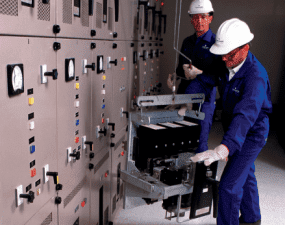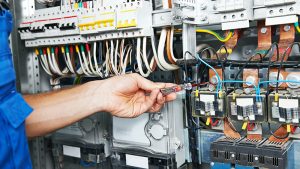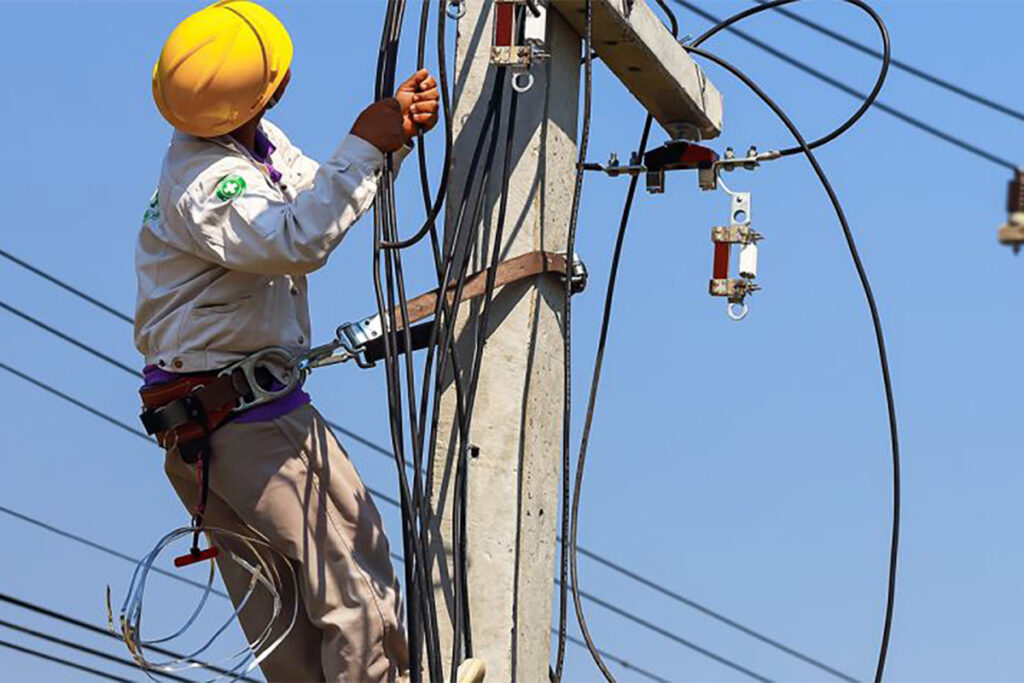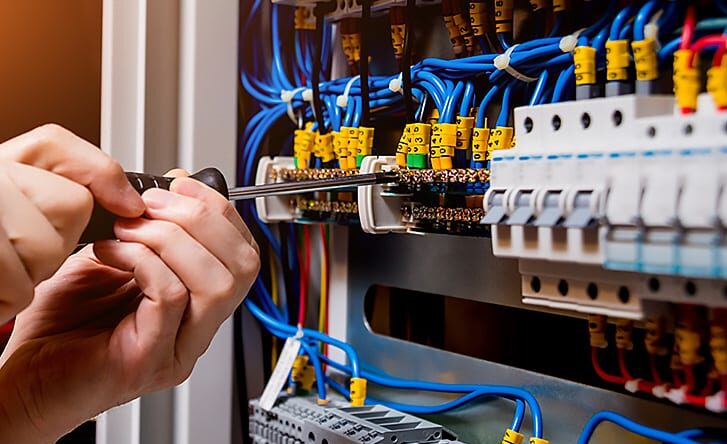Electrical Maintenance
are dedicated to providing a variety of services to meet all your electrical needs.
can provide thermal imaging to prevent loss of production and failure of critical components. We can complete new construction with any style specifications and voltages in the range of distribution. This includes reclosers, capacitors, platform racks and static overhead protection for batteries and SWD’s.
will provide maintenance to the pole line either energized or de-energized to suit the customer’s needs. A power quality analysis can be run to reduce energy cost, as well as fuse coordination to eliminate lease outages.
are equipped with a wide array of auger widths to accommodate any hole digging needs. We strive for excellence in all aspects of safety, quality and efficiency.

Electrical Maintenance
provides comprehensive full service electrical maintenance for industrial plants, large commercial facilities and municipal power stations. We are available 24 hours a day, seven days a week and are maintenance manager’s first choice for electrical testing, maintenance and repair
substation maintenance includes periodic inspections, repairs, and if necessary equipment replacement. It is a systematic series of preventative measures to ensure the safety of all personnel working around the equipment, and the quality of the equipment itself. The process normally includes visual and mechanical inspections that are carried out by trained professionals who look for signs of damage, corrosion, loose fittings, and displaced parts. Unforeseen shutdowns due to equipment malfunctioning are costly, however, with the right maintenance services, these shutdowns can be prevented.
Benefits of Maintenance
EPM (Electrical Preventative Maintenance) and MPM (mechanical preventative maintenance) that ensures the containment of problems before they occur. Potential errors are diagnosed and addressed before they are able to become hazardous to the health of the system and the personnel handling the system.
Benefits of EPM and MPM are listed below:
Extended equipment life cycle
Assurance that personnel are working under a safe environment
Keeps equipment operating at manufacturer’s standard to ensure reliability and safety
Maintenance prevents future wear and tear from occurring as well as reduces cost for repairs
To keep substations operating at peak conditions, major substation maintenance should be done annually
An Introduction to Substation Maintenance
If your organization runs with the support of a sub-station, you will obviously require periodic maintenance. Timely maintenance ensures that your sub-station operates efficiently, securely, and a in a manner that makes it reliable. Think of it as just one of those things that just needs to be done.
You see, after a point in time, a range of problems can affect your sub-station, especially in terms of reliability and performance If these issues are ignored, you can end up facing breakdowns and even safety issues. To make things worse, you’ll have to foot the costs that come with these issues.

ELECTRICAL MAINTENANCE AND FIBER OPTIC
Management information systems (MIS) in industrial business consist of an information technology and networking system. goal to develop advanced IT automation in order to find alternative and reliable solutions at a minimum cost. BPI is able to develop a complete networking system by effectively using
Fiber-optic technology
Advance database programming
Application software
OPC interfacing communication for advanced IT automation
Electrical Maintenance Testing and Engineering Services
testing and engineering service group, working in conjunction with Vertiv Services, offers a complete line of electrical maintenance testing and engineering services.
A comprehensive program of electrical services helps identify the root cause of system availability problems, avoid costly downtime, preempt emergency repairs, and maintain a safe operating environment.
There are two primary benefits from implementing effective preventive maintenance in a facility:
1) Reduced costs of repairs and minimized or eliminated downtime.
2) Safety for personnel and property damage.
Positives in Developing an Electrical Testing Program
Good economic judgment is necessary for developing an effective electrical preventive maintenance program. As indicated earlier, two objectives of such a program should be focused on enhancing safety and reducing equipment failure and loss. The program should include regular inspections, periodic testing and servicing of equipment, and effective record-keeping
There are four basic steps that should be taken to develop an electrical preventive maintenance program. First, compile a list of electrical equipment in the facility. Second, determine which equipment is most critical for the operation. Third, implement a monitoring system for length of use and duty cycles, and identify signs of failure or fatigue. Fourth, identify the resources needed to implement the maintenance program.
Training and Safe Work Practices.
The technician performing periodic maintenance and service of electrical equipment should have a thorough understanding of the electrical field and should be trained and familiar with the equipment and systems they must maintain and work on. Qualified and trained personnel understand the construction and operation of equipment and installations, and they have safety training to recognize and avoid the hazards involved.
Summary
Preventive maintenance is often ignored and considered too expensive to implement. In reality, it is a valuable investment that is measurable. Preventive maintenance can help avoid equipment failure, alleviate repair and replacement costs, and increase safety for personnel. It should not be treated as an unnecessary investment.
Electrical Maintenance
A job as an Electrical Maintenance Man falls under the broader career category of Electricians. The information on this page will generally apply to all careers in this category but may not specifically apply to this career title.
Job Description for Electricians : Install, maintain, and repair electrical wiring, equipment, and fixtures. Ensure that work is in accordance with relevant codes. May install or service street lights, intercom systems, or electrical control systems.
What skills are required for Electricians?
Troubleshooting – Determining causes of operating errors and deciding what to do about it.
Repairing – Repairing machines or systems using the needed tools.
Judgment and Decision Making – Considering the relative costs and benefits of potential actions to choose the most appropriate one.
Active Listening – Giving full attention to what other people are saying, taking time to understand the points being made, asking questions as appropriate, and not interrupting at inappropriate times.
Critical Thinking – Using logic and reasoning to identify the strengths and weaknesses of alternative solutions, conclusions or approaches to problems.
Installation – Installing equipment, machines, wiring, or programs to meet specifications.
Quality Control Analysis – Conducting tests and inspections of products, services, or processes to evaluate quality or performance.
Equipment Maintenance – Performing routine maintenance on equipment and determining when and what kind of maintenance is needed.
Active Learning – Understanding the implications of new information for both current and future problem-solving and decision-making.
Monitoring – Monitoring/Assessing performance of yourself, other individuals, or organizations to make improvements or take corrective action.
Speaking – Talking to others to convey information effectively.
Instructing – Teaching others how to do something.
Complex Problem Solving – Identifying complex problems and reviewing related information to develop and evaluate options and implement solutions.
Reading Comprehension – Understanding written sentences and paragraphs in work related documents.
Equipment Selection – Determining the kind of tools and equipment needed to do a job.
Coordination – Adjusting actions in relation to others’ actions.
Mathematics – Using mathematics to solve problems.
Learning Strategies – Selecting and using training/instructional methods and procedures appropriate for the situation when learning or teaching new things.
Operation Monitoring – Watching gauges, dials, or other indicators to make sure a machine is working properly.
Operation and Control – Controlling operations of equipment or systems.
Systems Analysis – Determining how a system should work and how changes in conditions, operations, and the environment will affect outcomes.
Systems Evaluation – Identifying measures or indicators of system performance and the actions needed to improve or correct performance, relative to the goals of the system.
Time Management – Managing one’s own time and the time of others.
Management of Personnel Resources – Motivating, developing, and directing people as they work, identifying the best people for the job.
Writing – Communicating effectively in writing as appropriate for the needs of the audience.
Service Orientation – Actively looking for ways to help people.
Social Perceptiveness – Being aware of others’ reactions and understanding why they react as they do.
Persuasion – Persuading others to change their minds or behavior.
Operations Analysis – Analyzing needs and product requirements to create a design.
What knowledge is needed to be an Electrician?
Building and Construction – Knowledge of materials, methods, and the tools involved in the construction or repair of houses, buildings, or other structures such as highways and roads.
Mechanical – Knowledge of machines and tools, including their designs, uses, repair, and maintenance.
Mathematics – Knowledge of arithmetic, algebra, geometry, calculus, statistics, and their applications.
English Language – Knowledge of the structure and content of the English language including the meaning and spelling of words, rules of composition, and grammar.
Design – Knowledge of design techniques, tools, and principles involved in production of precision technical plans, blueprints, drawings, and models.
Public Safety and Security – Knowledge of relevant equipment, policies, procedures, and strategies to promote effective local, state, or national security operations for the protection of people, data, property, and institutions.
Customer and Personal Service – Knowledge of principles and processes for providing customer and personal services. This includes customer needs assessment, meeting quality standards for services, and evaluation of customer satisfaction.
Administration and Management – Knowledge of business and management principles involved in strategic planning, resource allocation, human resources modeling, leadership technique, production methods, and coordination of people and resources.
Physics – Knowledge and prediction of physical principles, laws, their interrelationships, and applications to understanding fluid, material, and atmospheric dynamics, and mechanical, electrical, atomic and sub- atomic structures and processes.
Telecommunications – Knowledge of transmission, broadcasting, switching, control, and operation of telecommunications systems.
Education and Training – Knowledge of principles and methods for curriculum and training design, teaching and instruction for individuals and groups, and the measurement of training effects.
Engineering and Technology – Knowledge of the practical application of engineering science and technology. This includes applying principles, techniques, procedures, and equipment to the design and production of various goods and services.
Computers and Electronics – Knowledge of circuit boards, processors, chips, electronic equipment, and computer hardware and software, including applications and programming.
Clerical – Knowledge of administrative and clerical procedures and systems such as word processing, managing files and records, stenography and transcription, designing forms, and other office procedures and terminology.


